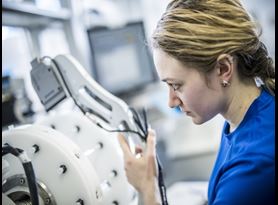Stent testing is an important step in the preclinical validation process to assess compliance with standards and regulatory requirements. Element’s cardiovascular device experts offer a comprehensive suite of stent testing services including pulsatile durability, axial fatigue, bending and torsion, inspections, and custom test methods.
Endovascular devices such as stents and stent-grafts are implanted through minimally-invasive procedures to address a vessel blockage and restore blood flow. From drug-eluting and bioresorbable stents to vascular grafts, our experts test to the latest standards for a variety of clinical indications and anatomical locations.
Our stent and graft testing expertise allows us to evaluate the devices with a range of testing and inspection methods to determine dimensional attributes, displacement and dislodgement force, tensile and bend strength, radial force measurements, and more.
Stent testing services
Pulsatile durability testing - ASTM F2477, ISO 25539-1, ISO 25539-2, ISO 7198
During pulsatile fatigue, Element tests devices in mock vessels mounted to a stent/graft tester, and subjects them to cyclical pressure pulses. The pulses create a dynamic radial strain in the mock vessel to simulate strains the device will experience in vivo.
In our Pulsatile Durability Testing of Complex Intravascular Devices article, we guide you through a step by step overview of pulsatile durability testing.
Axial fatigue testing - ASTM F2942, ISO 25539-1 and ISO 25539-2
Axial fatigue testing may be used in tension or compression to mimic physiological loading conditions. Two key axial fatigue tests are crush resistance and S/N curve generation.
Crush resistance testing: We use crush resistance quasi-static tests radially or along the length of a stent to measure the stent’s ability to resist permanent deformation or cyclic fatigue to mimic 10 years of implantation. This test configuration is particularly useful in fatigue to study the impact of overlapping vessel interactions.
S/N curve generation: Our experts outline S/N fatigue testing in our article Tips for Medical Device Fatigue Testing. Load monitoring can be added to ensure that the specimen sees the desired load throughout the test and to detect specimen failures.
Bending and torsion durability testing - ASTM F2942 and ISO 25539-2
These tests are applicable when the device’s clinical use would result in bending or torsional loading such as peripheral stent applications, especially superficial femoral artery (SFA) indications that experience additional loading caused by natural gait motion, running, sitting, and standing.
We have developed a wide variety of bend fixtures to accommodate bend tests such as pure bending, cantilevered, combined pure and cantilevered, constant radius, compression and shear-induced bending.
Torsion fatigue testing – ASTM F2942, ISO 25539-1, and ISO 25539-2
Element’s fixtures and test instruments can apply cyclical torsion loading to simulate a wide variety of clinical uses and anatomical locations, mounted directly on a test fixture or inside mock vessels and then secured on a test fixture. Multi-axial loading fixtures and instruments that apply tension/compression, bending and torsion simultaneously are also available.
Our article on Medical Device Torsion Testing describes torsional loading of peripheral stents.
Stent graft testing services
Vascular graft tests – ISO 7198
In addition to axial, torsional and pulsatile durability testing, there are several additional tests we offer for vascular grafts per ISO 7198 to characterize the following properties:
- Longitudinal tensile strength in its tubular form
- Circumferential tensile strength in its tubular form
- Pressurized burst strength in its tubular form
- Diaphragm pressurized burst strength and probe burst strength of graft in flat form
- Strength after repeated puncture with dialysis needles
- Suture retention strength
- Dynamic radial compliance
Inspection methods
Inspections are a key component of stent durability testing and are routinely performed before, during and after fatigue tests. Some inspections require device removal from the tester, such as microscopy, other methods require pausing the test, such as endoscopy, while methods such as high-speed video and stroboscopes are useful while a test is running.
The main inspection methods we employ during stent fatigue testing include:
- Visual
- Digital microscopy
- Endoscopes
- High-speed video
- Strobe light
- Media sampling for nickel ion release and particulate testing
For more information about our stent and stent graft testing services, or to request a quote, contact our cardiovascular device testing experts today.
Related Services

Preconditioning Stents for Fatigue through Simulated Use Testing
Simulated use testing of implantable cardiovascular medical devices is a well-established non-clinical engineering test used to serve many purposes including delivery, deployment and retraction of a stent.

Acute Particulate Characterization of Coated Drug-Eluting Stents
Our experts utilize Scanning Electron Microscope (SEM) paired with Automated Feature Analysis (AFA) software for the analysis phase of acute particle characterization of drug-eluting stents.

Abdominal Aortic Aneurysm (AAA) Testing
AAA devices are much larger than other intravascular devices in both diameter and length, which presents challenges for testing. Element engineers have learned to adapt our equipment to virtually any test application.

High Speed Stent and Graft Testers
Our medical device manufacturing customers are regularly challenged with short timelines to bring products to market.

